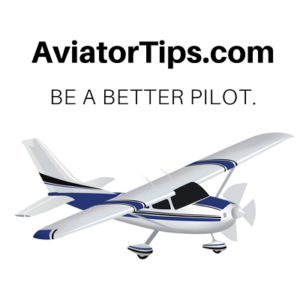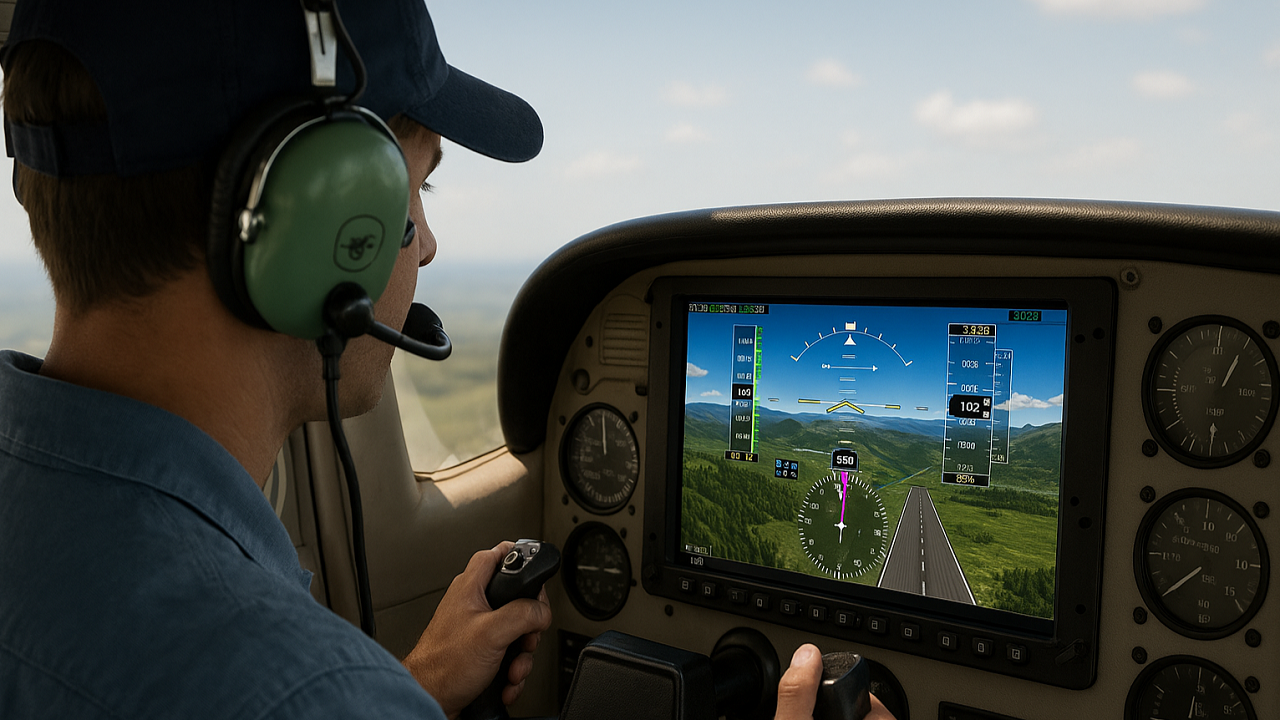Imagine flying through dense clouds, over unfamiliar terrain, or during a dark night approach and still having a crystal-clear view of the world outside. That’s what synthetic vision systems offer pilots. For student pilots and newly minted private pilots, this technology can feel like science fiction. But it’s real, it’s here, and it’s becoming more common in general aviation cockpits.
Synthetic vision systems, or SVS, turn your flight display into a virtual window using detailed terrain data and real-time positioning. They give you a view of the outside world even when visibility is poor or nonexistent. This article breaks down what SVS is, how it works, and why it matters for your training and everyday flying.
What Is a Synthetic Vision System (SVS)?
A synthetic vision system creates a computer-generated image of the environment outside your aircraft. It displays this 3D view on your primary flight display (PFD), combining terrain data, obstacle information, and your GPS position to simulate what you would see if visibility were perfect.
This synthetic view includes hills, valleys, runways, airports, obstacles, and sometimes even traffic. The result is a high-resolution image that looks like you’re flying on a clear day, even when you’re in clouds or flying at night.
SVS is not a camera. It doesn’t use real-time video. Instead, it builds a virtual world based on your position and heading, using databases and sensors.
How SVS Works
Synthetic vision pulls data from several sources to build its virtual view:
- GPS and inertial sensors tell the system your exact location, altitude, and flight path.
- Terrain databases contain detailed 3D maps of the Earth’s surface, including elevation and natural features.
- Obstacle databases include towers, buildings, and other structures that could pose a hazard.
- Runway and airport information is used to overlay the approach environment, lighting systems, and airport layout.
As the airplane moves, SVS updates in real time to match your heading, altitude, and flight path. This allows you to “see” mountains, obstacles, or airports even if you’re flying in clouds or darkness.
Key Features of Synthetic Vision Systems
While different avionics manufacturers have unique designs, most SVS displays include:
- 3D terrain rendering: Color-coded landscapes show elevation and terrain contours. Green, yellow, and red shading can indicate terrain clearance margins.
- Runway highlighting: Makes it easier to locate and align with runways, even in low visibility.
- Flight path marker (velocity vector): Shows exactly where the airplane is headed.
- Obstacles and terrain alerts: Towers, antennas, and other hazards are clearly marked.
- Horizon line and sky shading: Helps maintain orientation and situational awareness.
- Highway-in-the-sky (HITS): A series of boxes that guide you along your course or instrument approach path.
Some systems also include synthetic traffic and weather overlays when connected to ADS-B In or other data sources.
Benefits for Student and Private Pilots
1. Better Situational Awareness
The main benefit of synthetic vision is improved awareness of your environment. You can see what’s coming up—even when you can’t see out the window. This is especially helpful during:
- Night flights
- IFR conditions
- Approaches to unfamiliar airports
- Mountain flying
As a student or new pilot, this added awareness builds confidence and improves safety margins.
Disclaimer:
Student pilots should never attempt flight in low visibility or instrument meteorological conditions unless they are under the direct supervision of an authorized flight instructor and operating in compliance with applicable training regulations. Always follow your instructor’s guidance and only fly in weather conditions that match your current certification and experience level.
2. Safer Approaches and Departures
Runways are clearly shown on the SVS display, including their orientation and elevation. On approach, SVS helps with:
- Identifying the correct runway
- Sensing alignment issues early
- Maintaining a safe glide path
During departure, you can see terrain and obstacles beyond the departure end of the runway.
3. Enhanced Emergency Management
In an engine-out or forced landing scenario, SVS shows terrain and fields, giving you a much better sense of where to go. Some systems even provide glide range rings or terrain awareness alerts to assist in selecting a safe spot.
4. Improved IFR Proficiency
Even if you’re VFR only, using SVS helps reinforce IFR concepts. It can show approach paths, track alignment, and situational cues that are hard to grasp through instruments alone. For instrument-rated pilots, SVS improves orientation and reduces workload in high-stress scenarios.
5. Faster Learning Curve
SVS allows new pilots to build an intuitive sense of their surroundings. It reinforces the relationship between the instruments and the outside world. Many CFIs find that it helps students “get the picture” more quickly, especially during complex approach or departure procedures.
Popular Synthetic Vision Systems
SVS is available in a range of general aviation avionics platforms. Some of the most common include:
- Garmin G1000/G3X Touch: These glass cockpit systems offer SVS as an option, with smooth terrain rendering, runway highlighting, and flight path markers.
- Dynon SkyView: Common in experimental and light sport aircraft, SkyView includes synthetic vision and highway-in-the-sky guidance.
- Aspen Evolution Pro MAX: Retrofit glass panel with synthetic vision available for legacy aircraft.
- Avidyne Entegra and IFD Series: Advanced display systems with synthetic vision and full approach overlays.
- ForeFlight (with compatible hardware): The synthetic vision feature shows terrain and obstacles on an iPad using AHRS input from a connected ADS-B receiver like Sentry or Stratus.
Each system has its own strengths and integration level. Some are panel-mounted, while others run on portable tablets with additional sensors.
Limitations of SVS
While synthetic vision offers many benefits, it’s not perfect. It’s important to understand what it can and cannot do:
- It’s only as accurate as its data. If the terrain or obstacle database is outdated, you could miss a critical hazard.
- It doesn’t detect weather. SVS does not show clouds, precipitation, or turbulence. Always use other tools for weather avoidance.
- It can give a false sense of security. New pilots must remember to maintain visual scanning and not rely completely on the screen.
- It’s not a substitute for looking outside. Synthetic vision is an aid, not a replacement for visual flying. Overdependence can dull basic pilot skills.
Make sure to stay current on both SVS and raw instrument flying techniques. Balance is key.
Best Practices for Using SVS
Here are some tips to get the most out of synthetic vision as a student or private pilot:
- Learn in VFR first. Practice using SVS in clear weather to understand how it matches what you see outside.
- Use it to reinforce good habits. Track alignment, glidepath control, and terrain awareness all benefit from SVS.
- Combine it with traditional instruments. SVS is helpful, but do not ignore your attitude indicator, altimeter, and other core instruments.
- Stay up to date. Keep your obstacle and terrain databases current to avoid inaccurate displays.
- Practice with your instructor. Ask your CFI to show you how to use synthetic vision during cross-country flights, pattern work, and simulated emergencies.
Should You Train with SVS?
Many flight schools now have SVS-equipped aircraft, especially those with glass cockpits. But should you learn with it from the start?
Pros:
- Enhances safety and awareness during training
- Helps with mental orientation
- Reinforces instrument scanning and IFR understanding
Cons:
- May delay skill development in traditional instrument scanning
- Not available in all rental or test aircraft
- Could lead to overreliance early on
If your training aircraft has SVS, use it as a tool, not a crutch. Spend time flying without it, too. Remember, you might fly a plane later that does not have these features.
Final Thoughts
Synthetic vision systems are changing the way pilots see the world. They improve safety, reduce workload, and make it easier to understand your surroundings in challenging conditions. For student pilots and new private pilots, SVS is a powerful tool that enhances learning and builds confidence.
But like any tool in aviation, it’s only effective when used correctly. Stay sharp with your core skills. Learn what SVS can do and what it cannot. Train with intention, fly with awareness, and use technology as an aid to good airmanship, not a replacement for it.
Sources:
– FAA: *Pilot’s Handbook of Aeronautical Knowledge*
– Garmin: *G1000 NXi Synthetic Vision Overview*
– AOPA: *Using Synthetic Vision Safely*
– Dynon Avionics: *SkyView System Features*
– ForeFlight: *Synthetic Vision Capabilities*
Recent Posts
From Paper Charts to Digital: The Evolution of Navigation in the Cockpit
For decades, pilots relied on paper charts, plotters, and manual calculations to navigate the skies. Today, with the tap of a finger, flight plans can be built, modified, and flown using digital maps...
Flight Simulators: How Technology Is Training Today’s Pilots
When you think of pilot training, you probably picture flight time in a real airplane. But technology has added an important new dimension to aviation education: flight simulators. Whether you’re a...


